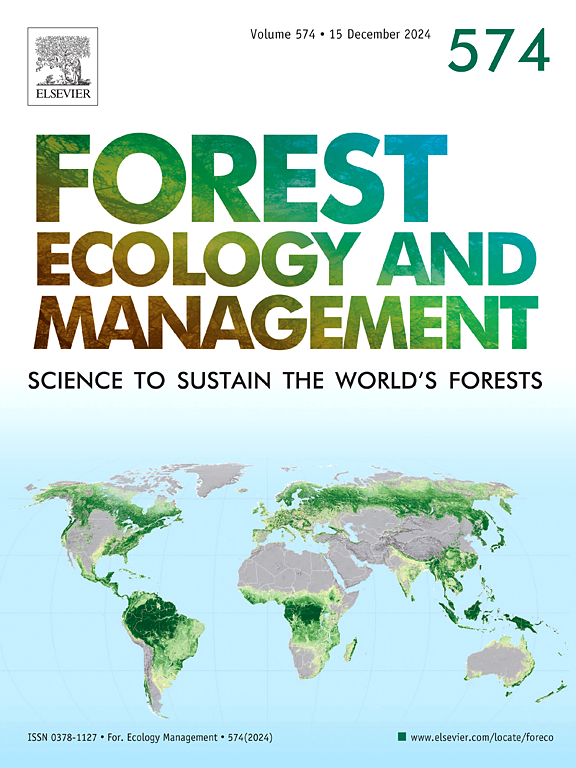Effects of exogenous and endogenous Mn on litter decomposition at different stages under continuous N addition in a subtropical forest
IF 3.7
2区 农林科学
Q1 FORESTRY
引用次数: 0
Abstract
Manganese (Mn) plays a critical role in the litter continuum decomposition during long-term nitrogen (N) deposition. Both endogenous Mn (present in fresh litter) and exogenous Mn (from the litter layer and soil) may be affected by chronic N deposition, potentially intensifying as N deposition continues. To investigate the effects of continuous N addition, prior N addition, exogenous Mn, endogenous Mn, and decomposition stage on litter decomposition, we utilized six types of fresh leaf litter with varying initial endogenous Mn concentrations, along with four types of unbroken and semi-decomposed litter collected from natural and prior N addition plots, in a litter decomposition experiment treated with continuous N addition and exogenous Mn. Continuous N addition significantly inhibited the decomposition of all ten litter types, while simultaneously enhancing Mn release in treatments without exogenous Mn. Initial endogenous Mn, combined with continuous N addition and exogenous Mn, jointly influenced litter decomposition. Exogenous Mn mitigated, rather than reversed, the inhibitory effect of continuous N addition on litter decomposition, despite a significant and nonlinear negative relationship between the effects of exogenous Mn and continuous N addition. Prior N addition substantially amplified the inhibitory effects of continuous N addition, particularly at 1.5-years of decomposition. Litter decomposition rates slowed as the decay progressed, showing significant differences between unbroken and semi-decomposed litter. Our findings recommend that exogenous Mn could be considered as a mitigation strategy for negative effects of N addition om litter decomposition. Forest management should take into account the various stages of litter decomposition when designing interventions.
外源和内源Mn对亚热带森林连续施氮不同阶段凋落物分解的影响
长期氮沉降过程中,锰在凋落物连续体分解中起关键作用。内源Mn(存在于新鲜凋落物中)和外源Mn(来自凋落物层和土壤)都可能受到慢性N沉降的影响,并可能随着N沉降的继续而加剧。为了研究连续N添加、预先N添加、外源Mn、内源Mn和分解阶段对凋落叶分解的影响,我们利用6种不同初始内源Mn浓度的新鲜凋落叶,以及从自然和预先N添加样地收集的4种未破碎和半分解凋落叶,进行了连续N添加和外源Mn处理的凋落叶分解实验。在不添加外源Mn的处理中,连续添加N显著抑制了所有10种凋落物类型的分解,同时促进了Mn的释放。初始内源Mn、连续N添加和外源Mn共同影响凋落物分解。尽管外源Mn与连续N添加之间存在显著的非线性负相关关系,但外源Mn减轻了而不是逆转了连续N添加对凋落物分解的抑制作用。事先加N大大增强了连续加N的抑制作用,特别是在1.5年分解时。凋落物分解速率随着腐烂的进行而减慢,在未破碎凋落物和半分解凋落物之间表现出显著差异。我们的研究结果表明,外源Mn可以被认为是一种缓解N添加对凋落物分解的负面影响的策略。森林管理在设计干预措施时应考虑到凋落物分解的各个阶段。
本文章由计算机程序翻译,如有差异,请以英文原文为准。
求助全文
约1分钟内获得全文
求助全文
来源期刊

Forest Ecology and Management
农林科学-林学
CiteScore
7.50
自引率
10.80%
发文量
665
审稿时长
39 days
期刊介绍:
Forest Ecology and Management publishes scientific articles linking forest ecology with forest management, focusing on the application of biological, ecological and social knowledge to the management and conservation of plantations and natural forests. The scope of the journal includes all forest ecosystems of the world.
A peer-review process ensures the quality and international interest of the manuscripts accepted for publication. The journal encourages communication between scientists in disparate fields who share a common interest in ecology and forest management, bridging the gap between research workers and forest managers.
We encourage submission of papers that will have the strongest interest and value to the Journal''s international readership. Some key features of papers with strong interest include:
1. Clear connections between the ecology and management of forests;
2. Novel ideas or approaches to important challenges in forest ecology and management;
3. Studies that address a population of interest beyond the scale of single research sites, Three key points in the design of forest experiments, Forest Ecology and Management 255 (2008) 2022-2023);
4. Review Articles on timely, important topics. Authors are welcome to contact one of the editors to discuss the suitability of a potential review manuscript.
The Journal encourages proposals for special issues examining important areas of forest ecology and management. Potential guest editors should contact any of the Editors to begin discussions about topics, potential papers, and other details.
 求助内容:
求助内容: 应助结果提醒方式:
应助结果提醒方式:


